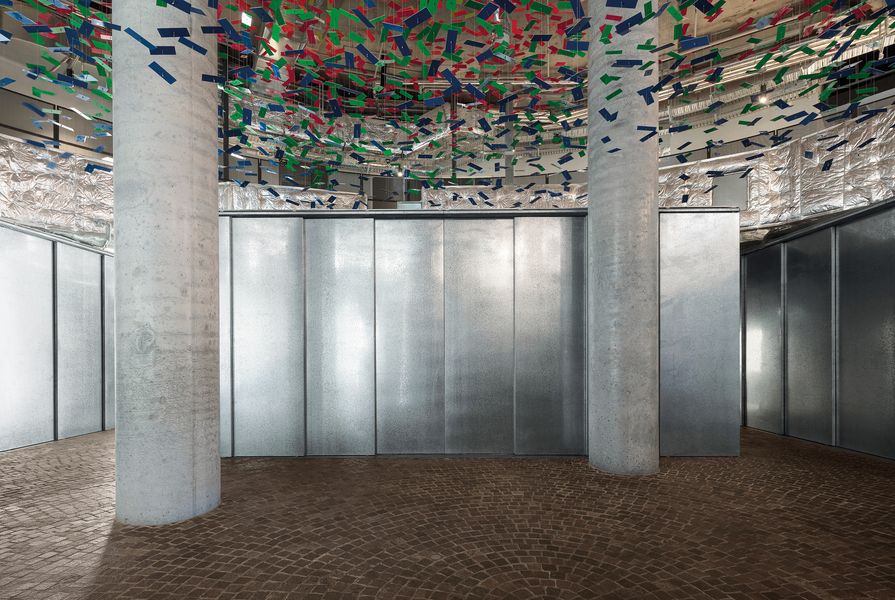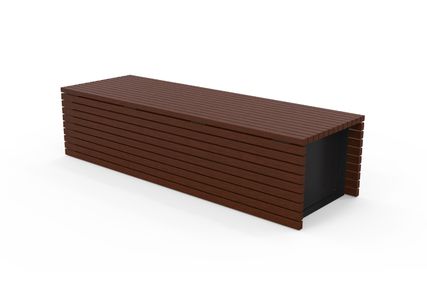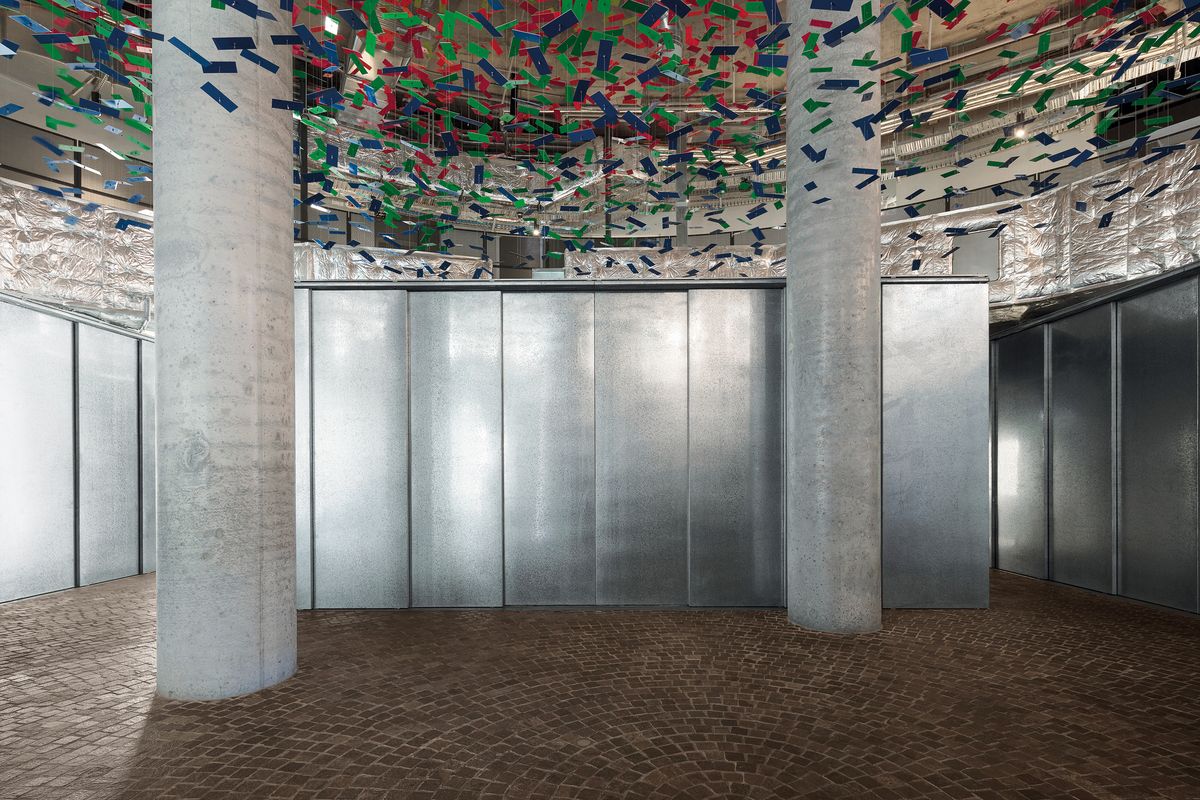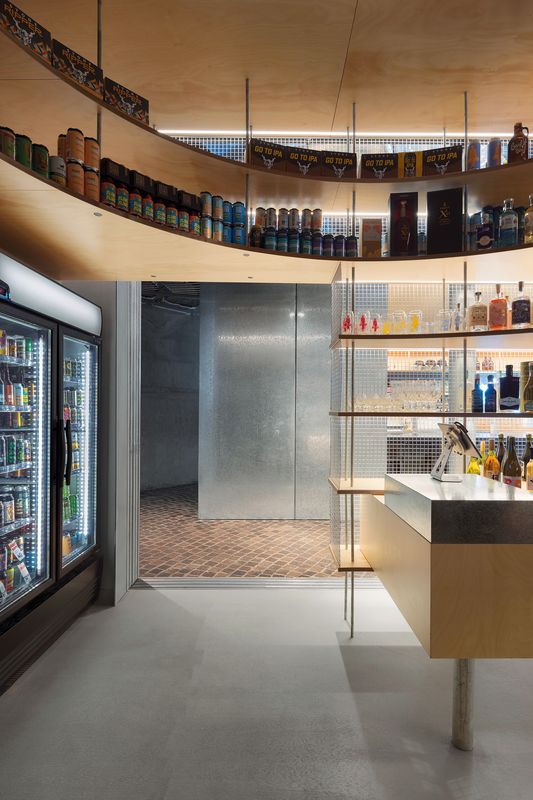Darling Square is the most recent piece in the New South Wales state government’s $4 billion-dollar redevelopment of Darling Harbour. Located on the edge of Chinatown on the southern side of the harbour, the centrepiece of the project is the Darling Exchange, a circular building by Japanese architect Kengo Kuma and Associates.
In 2017, Anthony Gill Architects (AGA) was one of three practices invited by developer Lendlease to pitch for the design of the market hall that would occupy the ground floor of Kuma’s Darling Exchange. The brief suggested that some tenants might be grocers, florists or bakers, while others would serve food and be open for breakfast or dinner, with an overlap during the day. Flexibility would be key to allow some outlets to shut while others remained open.
AGA is an office of five, deeply embedded in the gritty food and wine culture of Surry Hills. Its portfolio includes the revered restaurants and bars Ester, Berta and Poly (in the base of the Paramount House Hotel by Melbourne’s Breathe Architecture) as well as the recently completed Lovefish at nearby Barangaroo. This dozen or so interiors has given the practice a profile greater than its size would suggest and, collectively, reveals many of the firm’s tendencies, which include favouring a minimal, stripped-back aesthetic realized with constructional intelligence and material authenticity. While certainly raw, these spaces are also comfortable and inviting, unselfconsciously eschewing familiar design moves prevalent in many Sydney interiors. It is a brave and influential body of work.
Small-footprint, efficiently designed interiors maximize the interstitial spaces when open, creating atmosphere and personality.
Image: Benjamin Hosking
AGA’s research for the market hall focused on round buildings and, in particular, SANAA’s 21 st Century Museum of Contemporary Art in Kanazawa, Japan. Here, a circular glass facade houses a jumble of boxes containing a variety of functional programs that can operate independently, the space between the boxes creating an organizational network of connected paths. Moriyama House, also by SANAA, follows related lines. AGA reasoned that the best market halls were architecturally straightforward, with generous pedestrian areas and simple tenancies that, when open, allowed fresh produce to spill out, creating the atmosphere and personality of the space.
Following these threads, their idea was based on a series of simple, self-contained pods that slip past one another and flirt with their circular boundary. Sharing a robust material and formal language, they have a clarity that allows tenants to fit out their interior as they feel is appropriate. Programmatic flexibility was key so that, whether open or closed, day or night, each pod would still contribute to the quality of the space. Small-footprint, efficiently designed interiors maximize the interstitial spaces, conceived as streets for wandering, queuing or loitering. The radial-planned porphyry paving defining these common spaces, connecting interior and exterior, circles and squares while grounding the galvanized steel pods and setting up material frictions.
As the project progressed, the challenge was to strike a balance between clarity of concept and allowing each tenant the chance to express their individual character and needs. This was made somewhat easier as the design of individual tenancies was later rolled into AGA’s scope of work, with Lendlease delivering the base build component. There was also a discernible shift from fresh food to food production and service, pivotal as market hall blurs and becomes food court.
The challenge was to strike a balance between clarity of concept and allowing each tenant the chance to express their individual character and needs.
Image: Benjamin Hosking
Occupying the centre of Aspect Studios’ Darling Square (one of its best), the contrast between the clatter of galvanized boxes and their context is sharp. The space is challenging and unfamiliar but it rewards the curious, creating unexpected pockets of space, with panels sliding back to reveal tenants’ rich offerings. Like Kanazawa and Moriyama, the project is one of betweens; of holding and release, pinches, slips and edge conditions that collectively make for a layered and rich spatial experience.
Despite there being so many moving parts and shifting goals relating to market conditions and commercial viability, the architectural idea remains clear and Lendlease should be congratulated on its bravery. AGA has created a place that is neither market hall nor food court; rather, it is a place to explore, a meandering wetland of spatial and material experiences.
Products and materials
- Flooring
- Porphyry stone to match external ground treatment.
- Lighting
- Custom design by Light Practice.
- Furniture
- Custom market hall furniture by Koskela.
- Other
- ‘A Lifetime of Summers’ by Nike Savvas.
Credits
- Project
- Darling Exchange Market Hall
- Design practice
- Anthony Gill Architects
Sydney, NSW, Australia
- Project Team
- Anthony Gill, Isabell Adam, Luisa Campos, Aurelie Nguyen, Arne Heeres
- Consultants
-
Base build architects of record
Lend Lease Design
Base building architect Kengo Kuma and Associates
Builder Lendlease (base building); Wyatt Projects (tenancy boxes, fitouts); Promena, Proactive and Sitform (fitouts)
ESD The Footprint Company
Fitout engineer SDA Structures
Landscaping ASPECT Studios
Lighting Light Practice
Project manager Lend Lease Design
Signage and wayfinding Studio Round
- Aboriginal Nation
- Built on the land of the Gadigal people of the Eora nation.
- Site Details
-
Location
Sydney,
NSW,
Australia
Site type Urban
- Project Details
-
Status
Built
Completion date 2019
Design, documentation 36 months
Construction 9 months
Category Commercial, Interiors
Type Retail
Source
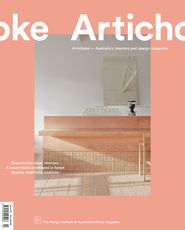
Project
Published online: 19 Nov 2020
Words:
Eoghan Lewis
Images:
Benjamin Hosking
Issue
Artichoke, September 2020

